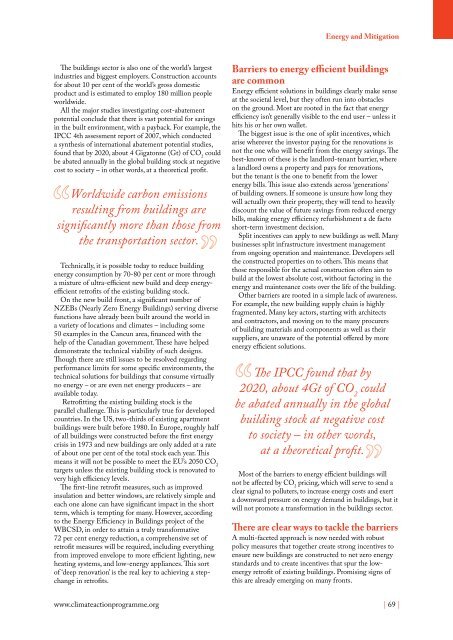Climate Action 2010-2011
Create successful ePaper yourself
Turn your PDF publications into a flip-book with our unique Google optimized e-Paper software.
Energy and Mitigation<br />
The buildings sector is also one of the world’s largest<br />
industries and biggest employers. Construction accounts<br />
for about 10 per cent of the world’s gross domestic<br />
product and is estimated to employ 180 million people<br />
worldwide.<br />
All the major studies investigating cost-abatement<br />
potential conclude that there is vast potential for savings<br />
in the built environment, with a payback. For example, the<br />
IPCC 4th assessment report of 2007, which conducted<br />
a synthesis of international abatement potential studies,<br />
found that by 2020, about 4 Gigatonne (Gt) of CO 2<br />
could<br />
be abated annually in the global building stock at negative<br />
cost to society – in other words, at a theoretical profit.<br />
Worldwide carbon emissions<br />
resulting from buildings are<br />
significantly more than those from<br />
the transportation sector.<br />
Technically, it is possible today to reduce building<br />
energy consumption by 70-80 per cent or more through<br />
a mixture of ultra-efficient new build and deep energyefficient<br />
retrofits of the existing building stock.<br />
On the new build front, a significant number of<br />
NZEBs (Nearly Zero Energy Buildings) serving diverse<br />
functions have already been built around the world in<br />
a variety of locations and climates – including some<br />
50 examples in the Cancun area, financed with the<br />
help of the Canadian government. These have helped<br />
demonstrate the technical viability of such designs.<br />
Though there are still issues to be resolved regarding<br />
performance limits for some specific environments, the<br />
technical solutions for buildings that consume virtually<br />
no energy – or are even net energy producers – are<br />
available today.<br />
Retrofitting the existing building stock is the<br />
parallel challenge. This is particularly true for developed<br />
countries. In the US, two-thirds of existing apartment<br />
buildings were built before 1980. In Europe, roughly half<br />
of all buildings were constructed before the first energy<br />
crisis in 1973 and new buildings are only added at a rate<br />
of about one per cent of the total stock each year. This<br />
means it will not be possible to meet the EU’s 2050 CO 2<br />
targets unless the existing building stock is renovated to<br />
very high efficiency levels.<br />
The first-line retrofit measures, such as improved<br />
insulation and better windows, are relatively simple and<br />
each one alone can have significant impact in the short<br />
term, which is tempting for many. However, according<br />
to the Energy Efficiency in Buildings project of the<br />
WBCSD, in order to attain a truly transformative<br />
72 per cent energy reduction, a comprehensive set of<br />
retrofit measures will be required, including everything<br />
from improved envelope to more efficient lighting, new<br />
heating systems, and low-energy appliances. This sort<br />
of ‘deep renovation’ is the real key to achieving a stepchange<br />
in retrofits.<br />
Barriers to energy efficient buildings<br />
are common<br />
Energy efficient solutions in buildings clearly make sense<br />
at the societal level, but they often run into obstacles<br />
on the ground. Most are rooted in the fact that energy<br />
efficiency isn’t generally visible to the end user – unless it<br />
hits his or her own wallet.<br />
The biggest issue is the one of split incentives, which<br />
arise wherever the investor paying for the renovations is<br />
not the one who will benefit from the energy savings. The<br />
best-known of these is the landlord-tenant barrier, where<br />
a landlord owns a property and pays for renovations,<br />
but the tenant is the one to benefit from the lower<br />
energy bills. This issue also extends across ‘generations’<br />
of building owners. If someone is unsure how long they<br />
will actually own their property, they will tend to heavily<br />
discount the value of future savings from reduced energy<br />
bills, making energy efficiency refurbishment a de facto<br />
short-term investment decision.<br />
Split incentives can apply to new buildings as well. Many<br />
businesses split infrastructure investment management<br />
from ongoing operation and maintenance. Developers sell<br />
the constructed properties on to others. This means that<br />
those responsible for the actual construction often aim to<br />
build at the lowest absolute cost, without factoring in the<br />
energy and maintenance costs over the life of the building.<br />
Other barriers are rooted in a simple lack of awareness.<br />
For example, the new building supply chain is highly<br />
fragmented. Many key actors, starting with architects<br />
and contractors, and moving on to the many procurers<br />
of building materials and components as well as their<br />
suppliers, are unaware of the potential offered by more<br />
energy efficient solutions.<br />
The IPCC found that by<br />
2020, about 4Gt of CO 2<br />
could<br />
be abated annually in the global<br />
building stock at negative cost<br />
to society – in other words,<br />
at a theoretical profit.<br />
Most of the barriers to energy efficient buildings will<br />
not be affected by CO 2<br />
pricing, which will serve to send a<br />
clear signal to polluters, to increase energy costs and exert<br />
a downward pressure on energy demand in buildings, but it<br />
will not promote a transformation in the buildings sector.<br />
There are clear ways to tackle the barriers<br />
A multi-faceted approach is now needed with robust<br />
policy measures that together create strong incentives to<br />
ensure new buildings are constructed to net zero energy<br />
standards and to create incentives that spur the lowenergy<br />
retrofit of existing buildings. Promising signs of<br />
this are already emerging on many fronts.<br />
www.climateactionprogramme.org | 69 |












